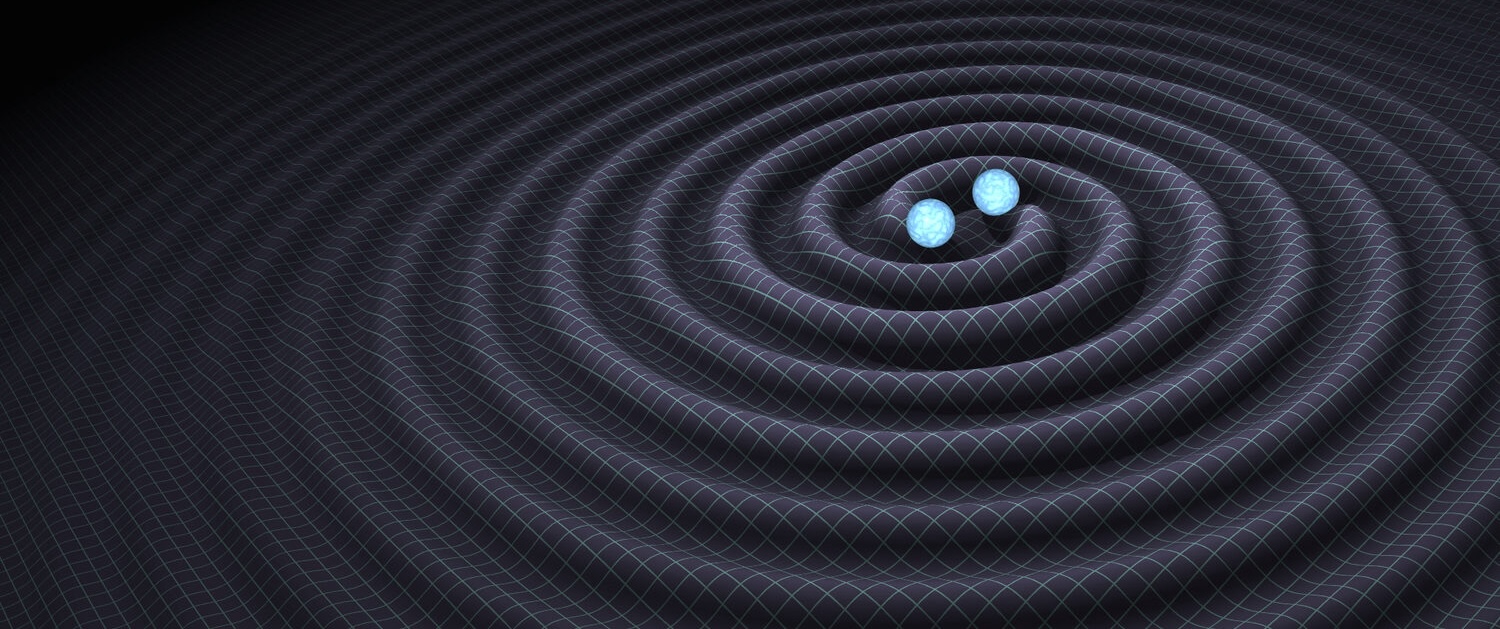In August 2025, the LIGO-Virgo-KAGRA (LVK) Collaborations released the interferometric strain data from the first part of the fourth observing run (O4a), which ran from May 2023 to January 2024. In this data, we have discovered 128 new confident gravitational-wave (GW) signals originating from merging black holes and neutron stars. Alongside the strain data release, we publish version 4.0 of the Gravitational Wave Transient Catalog (GWTC-4.0), which contains lists of the candidate signals and measurements of their properties. We are also publishing a set of papers that accompany the catalog. These papers are submitted to the Astrophysical Journal Letters for publication as a Focus Issue. Here, we summarise the first three of these papers that focus on the production and results from GWTC-4.0 itself.
Introduction
This paper, “GWTC-4.0: An Introduction to Version 4.0 of the Gravitational-Wave Transient Catalog”, provides an overview of the focus issue, including details of the other papers and important information to help a reader understand the nomenclature of the field.
What’s in a name?
We name our gravitational waves using the date and time that we detect them, in Coordinated Universal Time (UTC). The (chronologically) first new event in our catalog, denoted GW230518_125908, was detected on 18 May 2023 at 12:59:08 UTC. We add the prefix GW to all of the candidate signals we detect (this is slightly different to what we did in the past, as signals which we think were likely to be caused by terrestrial effects are now included in the catalog, but with additional data about why we think they might not be genuine gravitational waves).
Cumulative catalogs
The GW transient catalog is cumulative – in other words, GWTC-4.0 contains not only the new results observed in O4a but also all past catalogs. To illustrate this, in Figure 1 we show a timeline of all observing runs (coloured bands) and the data span of each catalog. You’ll notice that our catalogs follow a naming convention GWTC-<major>.<minor>, where the major number is incremented when the span of data increases and the minor number increments if there is a change in the methods/data describing the signals (e.g. a re-analysis of the data as happened with GWTC-2.1). In the past, we have routinely omitted the minor number when it was 0 (see, e.g. GWTC-3). However, we found that this can lead to some confusion – for example does GWTC-2 refer to GWTC-2.0 or GWTC-2.1? We will therefore now always include the minor number when referring to a specific catalog. However, we still omit the minor number when referring only to the data span (as shown in Figure 1).
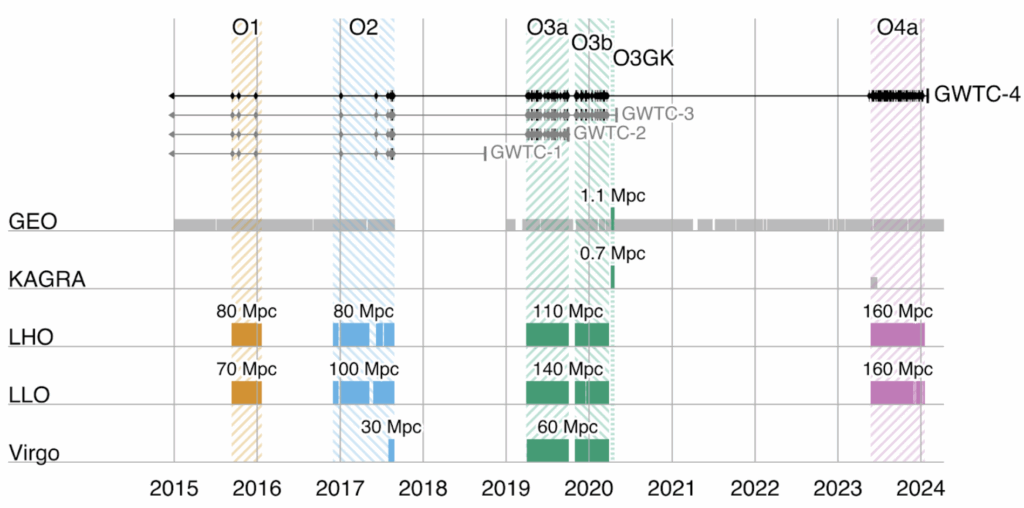
Figure 1: A timeline of observing runs showing the data-taking periods for the gravitational-wave observatories GEO, KAGRA, LIGO-Hanford (LHO), LIGO-Livingston (LLO), and Virgo. Numbers above the coloured blocks correspond to the approximate distance the detector can see a standard binary neutron star merger, providing a measure of the sensitivity. Along the top, we provide markers for when events have been added to the GWTC as well as horizontal bars showing the span of data in each catalog.
From Figure 1, you will also see that the two LIGO detectors were online during O4a: all candidate signals and measurements were made on just data from these two detectors. KAGRA did briefly take data during the beginning of the run, but the sensitivity was insufficient to contribute to the catalog results.
Within the introduction paper, we provide for the first time a detailed description of the evolution of the individual detectors. By collecting this information together in one place, we hope to better connect the astronomical community studying the observations with the instrumental community building the detectors.
Peeking into the dark
We can figure out the 4-dimensional volume in both time and space that the detectors have observed (we call this a ‘hypervolume’ because it’s a volume in more than three dimensions) by simulating signals and seeing if they are recovered, and then combining this information with details on the duty cycle of the detectors. In Figure 2, we plot an approximation to this hypervolume against the cumulative number of detections with a probability of astrophysical origin greater than 50%. This shows how many signals were detected in each observing run and visualises that in O4a, we have more than doubled the number of observed signals! The bands in the figure represent the uncertainty: while many candidates have a probability of astrophysical origin very close to 100%, those with a probability of 50% are just as likely to be a spurious noise fluctuation. Therefore, the bands capture how uncertain we are about the number of observed events.
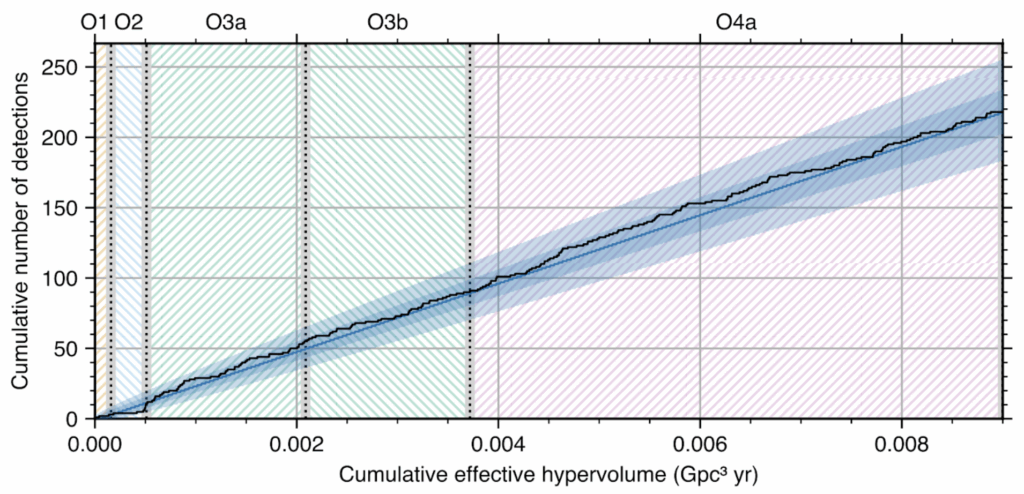
Figure 2: The cumulative number of detections (candidates found with a probability of being astrophysical greater than 50%) against the approximate space-time hypervolume surveyed by the detectors.
In the rest of the paper, we provide a review of observed transient gravitational-wave sources before ending with a synopsis. The review is not intended to replace the many excellent textbooks in the field, but to provide a short introduction to the language and mathematics we use to describe our sources throughout the focus issue. This ensures that we are consistent in our notation and provides a single point of reference for people interested in the field. We also include, as appendices, a table of frequently-used acronyms and glossary definitions and a short discussion defining conventions for data analysis.
The introduction paper sets the stage for the rest of the focus issue. While it contains no substantive scientific results itself, the intention is to remove duplication between other papers, ensure they remain consistent, and provide clear definitions for the field.
Methods
The methods paper, “GWTC-4.0: Methods for identifying and characterising gravitational-wave transients”, provides the details of the methodology used to produce GWTC-4.0. Starting with the development of theoretical waveform models for colliding black holes and neutron stars, we then move on to discuss the search pipelines that produce candidate lists. Each candidate is then subjected to data quality and candidate vetting before undergoing parameter estimation to understand the properties of the source and waveform consistency tests to validate the underlying assumptions.
Upping our game: the most complicated analysis yet
Since the end of O3 and the publication of GWTC-3.0, we’ve put a lot of effort into making our analyses even better. We’ve introduced new waveform models that better describe the physics of our sources and are computationally faster. Not only do we use the latest waveforms in GWTC-4.0, but we now use four different waveforms to analyse many of the events: twice the number used in GWTC-3.0, allowing us to better account for inaccuracies in the models. We have also tuned our search algorithms, introducing new approaches to improve the detection efficiency. Many of these improvements increased the complexity of constructing our catalog, and we’ve continued to develop innovative new technology for automating as much of the analysis as possible to allow us to do more and make sure that our results are easy to reproduce.
A historical perspective
In the methods paper, you may be surprised to find historical descriptions of the algorithms used as far back as the first observing run. This is due to the cumulative nature of the catalog: if old data is not re-analysed with new methods, then it is important when using results from those old events that users understand the methods that produced the results (which may be quite different from the methods run on new data). Therefore, in our methods paper, we provide a historical perspective as well as a description of the new changes to the methodology.
In summary, the methods paper gives an overview of the workflow we use, demonstrating how we leverage online/offline analyses, preliminary studies, and careful vetting to ensure the final products are rigorous and of the highest standard.
Results
More signals, more variety
We have found 128 new candidates that have a probability of being astrophysical greater than 50%. This brings the total number of candidates within the GWTC to 218 and doubles the size of the catalog! We’re presenting a detailed analysis of 86 of these new signals in this catalog. Making so many new detections has been enabled by increases in the sensitivity of the detectors themselves and developments in the analysis techniques we use to dig the signals out of noise.
It’s exciting to have so many new observations, as this new set contains both the bread-and-butter binary black hole mergers that the detectors have become so good at identifying, but also systems which contain black holes and neutron stars, which are different from anything which we’ve seen before.
From online to offline (and back again)
During O4, we have produced (as fast as possible) online public alerts on likely candidates. This enables other astronomers to perform follow-up observations to search for any light from the candidates. There were 1697 alerts in O4a, of which 82 were deemed highly likely to be astrophysical and did not have any data quality issues. As stated earlier, the catalog contains 128 highly probable candidates: these are the result of so-called “offline” analyses that use improved search methods. However, of these 128, just 8 were not found online! This demonstrates that the online searches are doing a good job of finding most of the candidates, ensuring astronomers have highly accurate information to work with.
Matter of interest
Two of the catalog members seem to have been produced by black holes merging with neutron stars. Signals like these are very interesting because, in comparison to mergers between black holes, which involve little or no “real” matter, the presence of matter from the neutron star can potentially be measured in the signal. For the two signals, we didn’t manage to detect any of these effects, but the more signals like these that we see, the more likely it is we’ll eventually be able to measure matter effects.
Mass effect
We can directly measure the mass of the binary from the signal. In Figure 3, we show the most likely values of the mass of the two components: this illustrates that, while we didn’t find any new binary neutron stars (in the lower-left hand corner), we do find very interesting likely neutron-star black holes and new events with total masses greater than 150 solar masses!
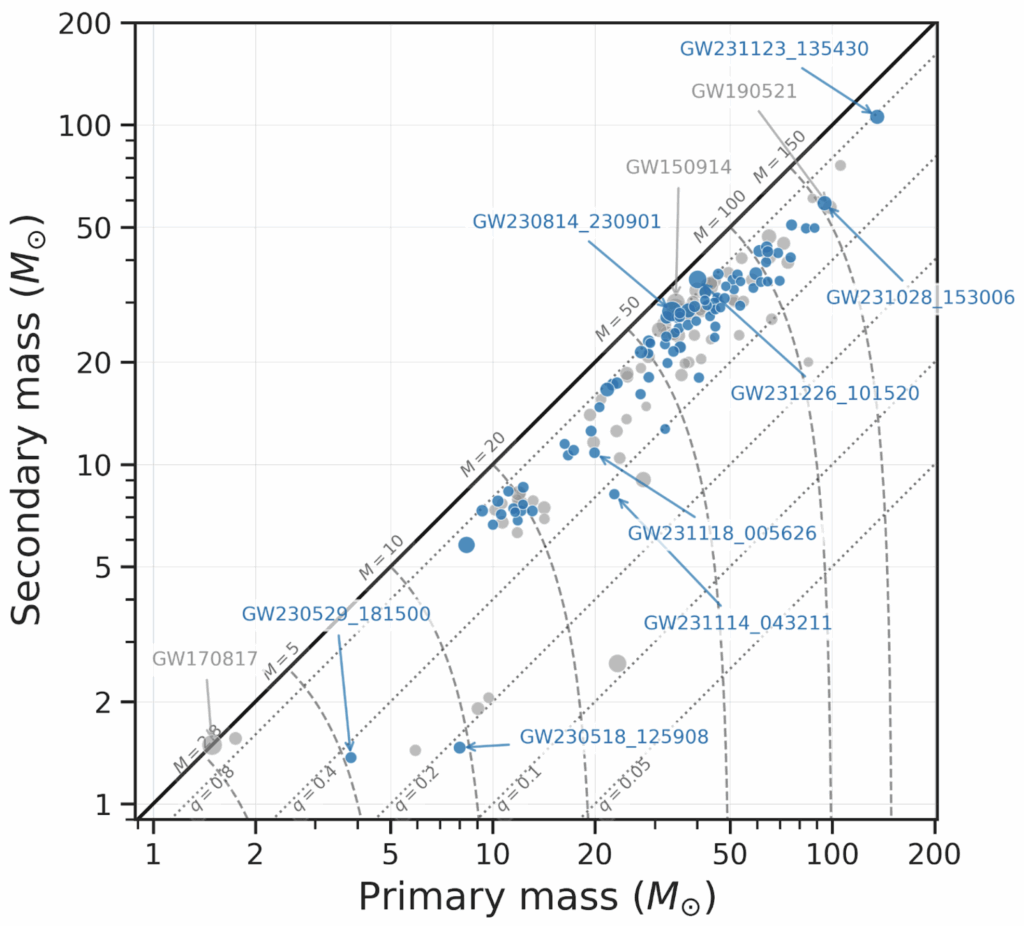
Figure 3: The mass-mass plot showing new candidates found in O4a (in blue) and candidates from O1-O3 (in gray). These are point estimates which ignore the substantial uncertainty and report only the most likely values. For each candidate, the size of the marker is proportional to its network signal-to-noise ratio. Dotted lines denote different values of the mass ratio, q, of the secondary mass divided by the primary mass, and dashed lines denote different values of the total mass. All masses are in solar masses. (Credit: G. Ashton, Royal Holloway University of London.)
The right spin
We can measure two properties of the black holes or neutron stars themselves, which are part of the merger: their mass and whether they are spinning. If so, we can measure the speed at which each of them is spinning and the relative orientation of the axes each of them is spinning. We calculate a value called the “effective spin” for each signal, which provides a useful overview of the two components’ spin. A large positive effective spin implies that one or both components are spinning fast, and they are spinning in the same direction; a negative effective spin tells us that the components are spinning in opposite directions.
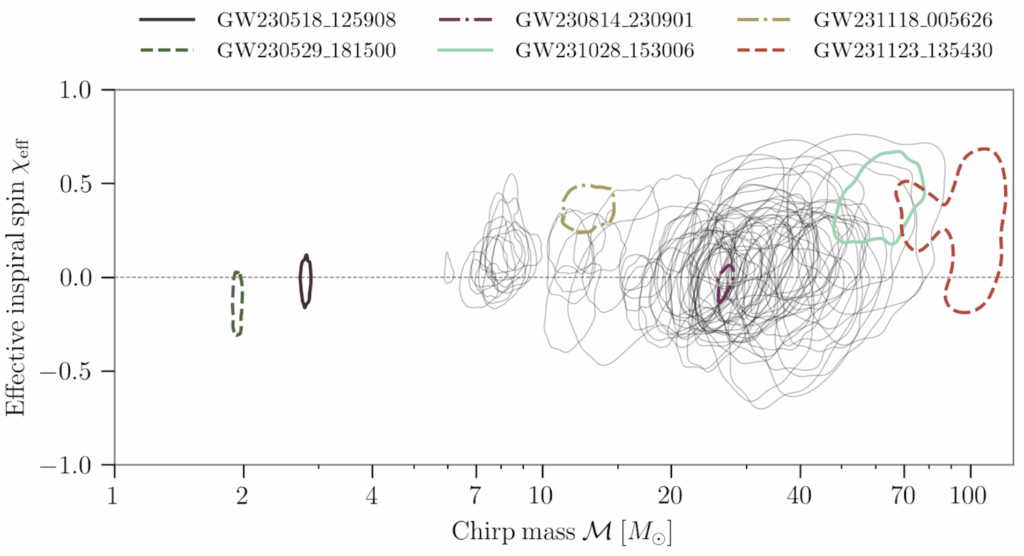
Figure 4: A plot of the chirp mass against the effective spin for all of the new candidates in GWTC-4.0 with a selection of especially interesting candidates highlighted in color. Each contour encloses the 90% confidence region for the parameters of that candidate.
GWTC-4.0 doubles the number of known gravitational wave signals. This is a fantastic achievement and a testament to the many improvements to the detectors. The new signals provide us with many new insights about black holes and neutron stars and will generate great excitement within the community, enabling a vast array of new studies.
Find out more:
- Visit our websites:
- Read a free preprint of the full scientific articles:
Back to the overview of science summaries.

